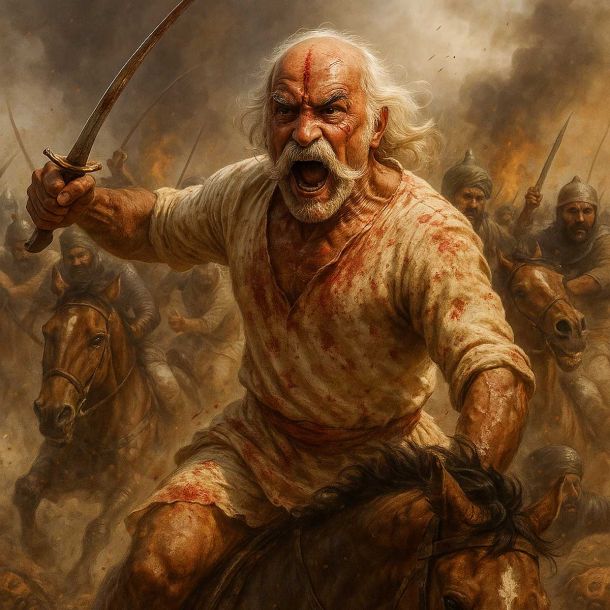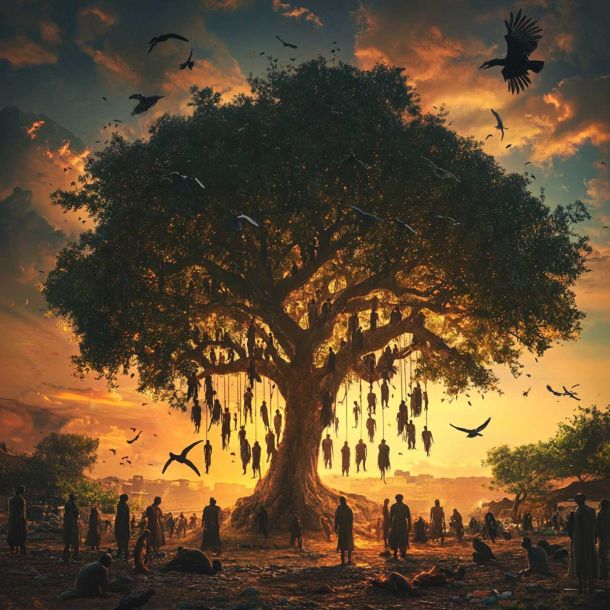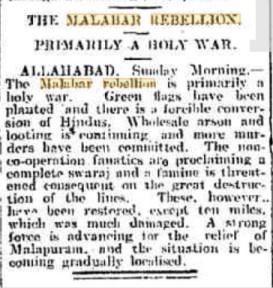Sanatan Articles
Satyaagrah
Written on
Satyaagrah
Written on
Satyaagrah
Written on
Satyaagrah
Written on
Satyaagrah
Written on
JOIN SATYAAGRAH SOCIAL MEDIA
Moplah Genocide of the Malabar Hindus, 1921: Thousands of Hindus slaughtered
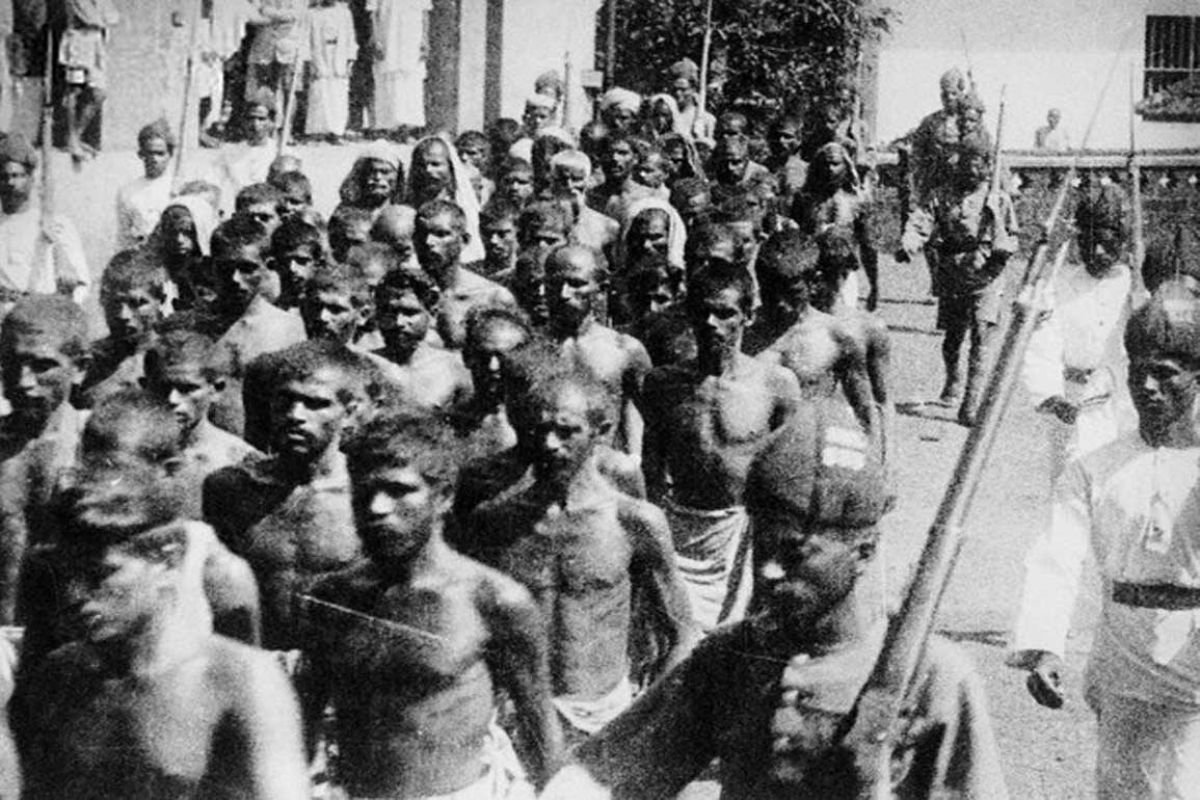
What we are witnessing today is the spectacle of Kerala being turned into a graveyard of historical facts. Distorted and dubious historical narratives—manufactured in a bid to build an even more toxic narrative —are being reinforced and celebrated with scant regard for historical facts and events. The most disturbing and insensitive aspect of the whole exercise is the role played by so-called historians in pushing the fabricated narratives on a people who were hapless victims of one of the worst communal pogroms recorded in the annals of Indian history.
Ever since India became an independent democracy, there has been a concerted effort to whitewash the notorious Malabar riots of 1921 and project it as either a peasant uprising against exploitative landlords or link it with the freedom struggle. Although these discussions mostly remained in the realm of academia, in the run up to the centenary year, there has been a renewed and motivated campaign to mainstream this distorted narrative through cinema and other mediums and graft it onto the collective conscience of the people. It seeks not only to blur the facts that still live in public memory but also bury them further down so that the ugly aspects of the riots never face historical scrutiny.
Perpetrator: Moplah / Mappila Muslims of Kerala
Year: 1921-22
Number: 2500 Hindus slaughtered, at least 26000 fled as refugees, at least 2500 forcibly converted, sexually assaulted, and more than 100 Hindu temples destroyed.
The Moplah Hindu Genocide, or the Malabar Rebellion, or the Mappila Rebellion, or the Moplah Riots refer to a series of incidents in the history of mankind, where Hindus were not only butchered, but the entire incident was either wiped out from history in entirety, or twisted to fit a pre-decided story. The Moplah Rebellion of 1921-22 was a rebellion gone wrong, where the rebels targeted Hindus, apart from attacking the British Establishment.
Who Were Mappilas?
The term “Mappila” is from Malayalam and translates to “honored / great child,” referring to all the “guests” or invaders to Kerala, especially in the Malabar region. Mappilas were some of the earliest Muslims settled in South Asia, and had a direct connection with Arab, through spice trade routes with the Gulf. Till 1498, the Mappilas lived & grew their trades in the region, due to the tolerance shown by Hindus. During this period, inter-faith marriages between Hindus & Muslims were common, and many Hindus converted to Islam due to marriages (whereas there is no account of Mappilas converting to Hinduism).
On the arrival of Europeans like Vasco da Gama in 1498, Mappilas were sidelined, their trade & commerce squeezed, and Arab trade routes curtailed. Mappilas were not entitled to inherit any lands, which were owned by Hindus. Mappilas were shown no tolerance by European imperialists, who persecuted them commercially and otherwise, leading to a growing animosity in the Mappilas towards Hindus, who they started to see as their rivals, as well as towards Europeans.
“The Portuguese attitude reflected the medieval European tradition, and was well represented by the governor of Goa, Afonso Albuquerque (d 1515), who dreamt of destroying Mecca and who bitterly persecuted his Mappila opponents.” |
| The Supreme Muslim Council: Islam Under the British Mandate for Palestine , p 459, Uri M. Kupferschmidt |
This brand of “pepper politics” shown by Portuguese, then Dutch (1656), then British (1662), then French (1775), led to militancy and religious fanaticism in Mappilas, who were now landless & poor & persecuted by Christian lords. During the reign of Hyder Ali (1782) and Tipu Sultan (1799), the Mappilas gained some prominence, but the hatred towards Hindus, sown by Islamic invaders, took permanent ground. When the British gained full power (1792), the hopes of the Mappilas to prosper were squashed, and they were more bitter than ever before.
During the period 1821-1921, there were 51 militant outbreaks of the Mappilas. These outbreaks were not fueled just by agrarian discontent or commercial interests, but were waged in the spirit of Jihad, against everyone they saw as their opponents–be it Christian rulers or Hindu landlords (jenmis).
Khilafat Movement, Non-Cooperation Movement Instigated The Moplah Rebellion
The Khilafat movement was an uprising of Indian Muslims in support of the Islamic caliphate, in the wake of World War I. It was aimed at Islamic dominion over India, by destroying the British empire, with support from the Ottoman Empire (which was eventually exterminated in late 1922).
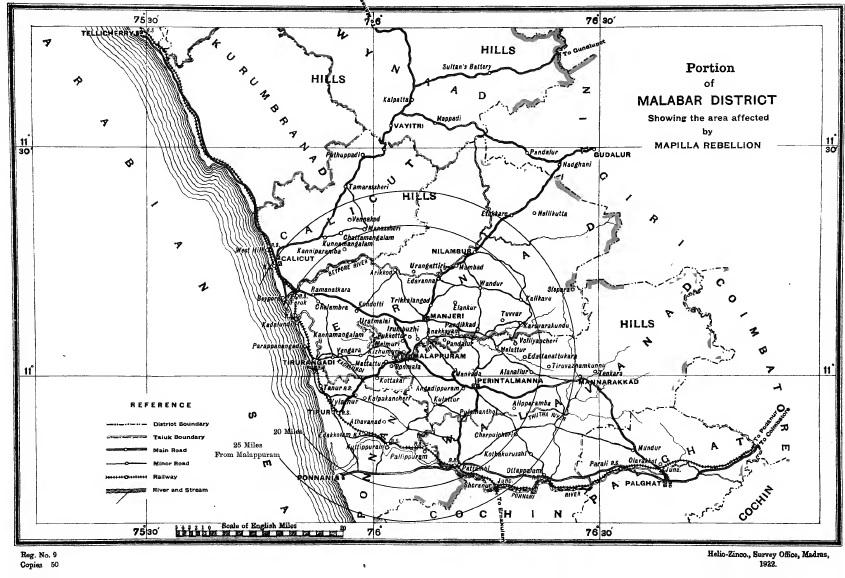 |
The Khilafat Movement, led by the Ali brothers, had full support of M. K. Gandhi, who promised the support of Hindus as well to the Ali brothers—Shaukat Ali, Mohammad Ali Jauhar and Abul Kalam Azad—knowing fully well that they would attack Hindus should they fail to support them. The Ali brothers had clearly informed M. K. Gandhi that if the Afghans invaded India to wage “holy war” or Jihad, they would fight not just the British, but the Hindus as well. Gandhi agreed to this, and asked Hindus to support the Khilafat Movement, and to submit to the dictates of the Mohammedans in matters of controversy.
“The Imperial Government have knowingly flouted religious sentiments dearly cherished by the 70 millions Mussalmans…If the Mussalmans of India offer non-cooperation to Government in order to secure justice on the Khilafat, it is the duty of every Hindu to cooperate with their Moslem brethren.” |
| M. K. Gandhi’s speech to 20,000 people. Moplah Rebellion 1921, C. Gopalan Nair, p 19-22 |
Khilafat Movement gained force in Malabar as well, due to his patronage, and fueled the Malabar or Moplah Rebellion.
“Last month Gandhi wrote in Young India: “For himself he can clearly see the time coming when he must refuse obedience to every single State-made law, even though there may be a certainty of bloodshed.” The Ali brothers, who were kept under restraint during the Great War and the Afghan War, for being in traitorous correspondence with our foreign enemies—a crime for which they should have been tried and punished—have been set free, and openly state that they would do all they can to help the Afghans in the event of a Jehad against the British in India, calling upon all true Muhammadans to do likewise. They have been allowed to preach that doctrine in Malabar in spite of the protest of the District Magistrate, who was not allowed to prohibit the seditious meetings. Can there be any reasonable doubt that this was the main cause of the Mapilla rebellion?” |
| Extract of letter by Sir Michael O’ Dwyer to Daily Telegraph |
The Congress, under the leadership of M. K. Gandhi, supported the Khilafat Movement, under the garb of the non-cooperation movement, which spread to Malabar.
“The Congress had adopted the principle of non-co-operation; Khilafat and non-co-operation movements were indistinguishable;…Every Moplah centre had a Khilafat association, with a Moplah president, a Moplah secretary and a majority of Moplah members.” |
| Moplah Rebellion 1921, C. Gopalan Nair, p 19 |
The Moplah rebels were armed with knives and ammunition, and had planned the attack on the British, and Hindus, lest they fail them. They asked the Hindu landowners to give them
weapons, and the trusting Hindus, not knowing what was headed their way, gave them knives which would eventually slit their own throats.
Mappilla Rebellion—An Outcome Of Jihad
Many scholars have argued that the Mappila rebellion (and earlier outbreaks) were an outcome of agrarian troubles and economic distress. But this was not the case. If that were so, Hindus who were working as peasants had the same opportunity and motive to rebel against the jenmis, or against the earlier Islamic rulers while they were in power and oppressed Hindus. But instead, Hindus of Malabar had fled and abandoned their homes during the reign of Hyder Ali & Tipu Sultan.
“Agrarian grievances were obviously not sufficient to spark violence in the rural Malabar among the Mappillas, or the agricultural population in general. It is the Islamic character of the Mappilla outbreaks that suggests why they cannot be tied to the eviction rate, and why none occurred among the Hindu population. All of the outbreaks, even those that had agrarian grievances as the immediate cause, were conducted in an unmistakable Islamic idiom – the Jihad. Each was expressed as a religious act because the Mappillas were inspired by the militant teachings of a small group of Mappilla religious leaders.” |
| Dale, S. (1975). The Mappilla Outbreaks: Ideology and Social Conflict in Nineteenth-Century Kerala. The Journal of Asian Studies, 35(1), 85-97. doi:10.2307/2054041 |
The Mappilla rebellion was a bigger catastrophe for Hindus than the earlier outbreaks, because it was an organized movement, amplified by the Khilafat movement, which made it a planned crime, rather than discrete outbreaks by discontent religious militants.
“…in 1921, the Khilafat movement added the crucial elements of ideology and organization to the pre-existing traditions of religious militancy and social conflict. It was this addition, more than anything else, that distinguished the Mappilla rebellion from all the earlier outbreaks.” |
| Dale, S. (1975). The Mappilla Outbreaks: Ideology and Social Conflict in Nineteenth-Century Kerala. The Journal of Asian Studies, 35(1), 85-97. doi:10.2307/2054041 |
The Moplah Rebellion Gone Wrong
The few Hindus of Malabar who had joined the non-cooperation movement were not prepared for the violence & wreckage the Mohammedans had planned.
“Distressed by the violence, most Malabar Hindus withdrew from the struggle, which, by default, became the Mappila revolt.” |
| The Supreme Muslim Council: Islam Under the British Mandate for Palestine by Uri M. Kupferschmidt, p 459 |
Hindus withdrew from the Malabar rebellion almost as soon as it broke out. This incurred the wrath of the Jihadi Mapillas on the Hindus apart from the British, who were trying to contain the troops of rebels.
The rebellion continued for 6 months, during which period, atrocities of every kind were meted out to Hindus. It had severe fallout for the Mappilas as well. More than 200 Mappilas were executed, 502 were sentenced to life imprisonment, and approximately 50,000 were imprisoned or exiled to Andaman, and heavy fines were levied on them by the British government. The zealotry exhibited by the Mappilas was shocking, and it was evident that their war was not just for liberation from British, but for Islamic dominance.
Annie Besant Statement
Annie Besant wrote her experience in ‘New India’ in the year 1921 that a pregnant woman carrying a seven months baby was cut through the abdomen by a rebel and she was seen lying dead on the way with the child protruding out of her womb. In another incident, Annie Besant writes that a six months old child was snatched from her mother and cut into two pieces in front of her. Many also report that women were raped in front of their brothers and husband. An incident of the British brutality was evident from an account where two girls, who were trying to protect their rebel father, were shot by the army. Various accounts by historians recall the killing of innocent women and children during the British suppression of the Rebellion.
Madhavan Nair (Gandhi and Anarchy - By C.S. Nair)
Truth is infinitely of more paramount importance than Hindu-Muslim unity or Swaraj, and therefore, we tell the Maulana Sahib and his co-religionists and India's revered leader Mahatma Gandhi—if he too is unaware of the events here—that atrocities committed by the Moplahs on the Hindus are unfortunately too true and that there is nothing in the deeds of Moplah rebels which a true non-violent non-co-operator can congratulate them for. What is it for which they deserve congratulation? Their wanton and unprovoked attack on the Hindus, the all but wholesale looting at their houses in Ernad, and parts of Valluvanad, Ponnani, and Calicut Taliques; the forcible conversion of Hindus in a few places in the beginning of the rebellion and the wholesale conversion of those who stick to their homes in its later stages, the brutal murder of inoffensive Hindus, men, women, and children in cold blood, without the slightest reason except that they are "Kaffirs" or belong to the same race as the Policemen, who insulted their Tangals or entered their Mosques, the desecration and burning of Hindu Temples the outrage on Hindu women and their forcible conversion and marriage by Moplahs; do these and similar atrocities proved beyond the shadow of a doubt by the statements recorded by us from the actual sufferers who have survived, deserve any congratulation? On the other hand should they not call forth the strongest condemnation from all right-minded men and more especially from a representative body of Mohamedans like the Khilafat Conference pledged to non-violence under all provocation? Did the Moplahs, who committed such atrocities, sacrifice their lives in the cause of their religion?
Maulana Mohani justifies the looting of Hindus by Moplahs as lawful by way of commandeering in a war between the latter and the Government or as a matter of necessity when the Moplahs were forced to live in jungles. Maulana perhaps does not know that in the majority of cases, the almost wholesale looting of Hindu houses in portions of Ernad, Valluvanad and Ponani Taluques was perpetrated on the 21st, 22nd, and 23rd of August before the military had arrived in the affected area to arrest or fight the rebels even before Martial law had been declared. The Moplahs had not betaken themselves to jungles at the time as Moulana supposes nor had the Hindus as a class done anything to them to deserve their hostility. The out-break commenced on the 20th of August, the police and the District Magistrate withdrew from Tirunangadi to Calicut on the 21st and the policemen throughout the affected area had taken to their heels. There was no adversary to the Moplahs at the time whom the Hindus could possibly have helped or invited, and the attack on them was most wanton and unprovoked.
Atrocities On Hindus In The Moplah Rebellion
During the entire Moplah Rebellion, unspeakable, unimaginable atrocities were committed against Hindus, which is why it should rightly be called the Moplah Hindu Genocide. By not doing so, a severe injustice is done to those who gave their lives and livelihoods due to the Islamic Jihad waged on them.
The total figure of at least 2,500 Hindus brutally slaughtered, and another 2500 forcibly converted, is quoted in several accounts. Other brutalities include violating the modesty of women, butchering children, and forcing Hindus into submission and death. These atrocities were reported in international news dailies and accounts of the district magistrates and other police officials.
“In the Arya Samaj registers alone 1766 cases of forced converts have been recorded and if the figures from all relief committees were collected, their number is sure to exceed 2500.” |
| Pandit Rishi Ram’s Letter, Moplah Rebellion 1921, C. Gopalan Nair , p 119 |
It was confirmed on an international level that the Moplah Rebellion was, indeed, a “holy war” or Jihad, in accordance with the Khilafat movement.
“The Malabar Rebellion. Primarily a Holy War.
Allahabad, Sunday Morning— The Malabar rebellion is primarily a holy war. Green flags have been planted and there is forcible conversion of Hindus. Wholesale arson and looting is continuing and more murders have been committed. The non co-operation fanatics are proclaiming a complete swaraj and a famine is threatened consequent on the great destruction of the lines…”
Daily Telegraph (Launceston, Tas. : 1883 – 1928), Monday 29 Aug, 1921. Retrieved via http://bit.ly/2XEMwwa
Hindus were exterminated systematically, to the shock of the British officers as well. They did not anticipate such mass violence against Hindus by the Moplahs.
“Malabar Rebellion | Moplah Atrocities
Allahabad, Wednesday. At Kuttipuram, 200 Moplahs, with swords and knives, raided the police station and wounded five constables. Diabolical atrocities are reported. Hindus being forced to dig their own graves before they are butchered. One was flayed alive for helping the troops, and two policemen were hacked to death near Nilambur.
Refugees are pouring into the troop centres, but there are difficulties in provisioning even for the military. They report that the extermination of Hindus is proceeding systematically but favoured women and girls are retained.”
World (Hobart, Tas. : 1918 – 1924), Friday, 7 Oct, 1921. Retrieved via http://bit.ly/2XE4cbd
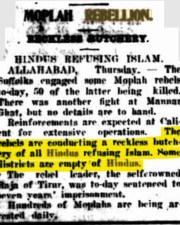 Moplahs committed every type of atrocity on Hindus, from slaughtering their cattle, to murder, arson, loot, and sexually assaulting women.
Moplahs committed every type of atrocity on Hindus, from slaughtering their cattle, to murder, arson, loot, and sexually assaulting women.
“Moplah Rebellion. Reckless Butchery.
Hindus Refusing Islam. Allahabad, Thursday
“….The rebels are conducting a reckless butchery of all Hindus refusing Islam. Some districts are empty of Hindus…”
Advocate (Burnie, Tas. : 1890 – 1954), 8 October, 1921. Retrieved via http://bit.ly/2XBDq3x
 The situation for Hindus kept getting worse, as the days progressed.
The situation for Hindus kept getting worse, as the days progressed.
“Malabar Rebellion
Slaughtering Hindus | Unrest at Madras
Allahabad, Friday—Calicut is overflowing with refugees reporting that the Moplahs are now not offering the choice of conversion, but are slaughtering Hindus indiscriminately. A reinforcement for the British troop guard is arriving…”
World (Hobart, Tas. : 1918 – 1924), Monday, 10 Oct, 1921. Retrieved via http://bit.ly/2XEMCnw
The Moplah rebellion turned most of the Hindus in that region into refugees. As the rebellion progressed, more and more Hindus were internally displaced, and took refuge in the refugee camps or in the jungles.
Malabar Rebellion | Hindus Forcibly Converted
Lahore, Monday— The number of refugees in the various camps on the Malabar coast is now nearly 10,000, and they are still arriving. Native troops reconnoitering killed six rebels…Ernad refugees report that 31 Hindus were seized, and 23 forcibly converted to Islam, while one was killed…”
World (Hobart, Tas. : 1918 – 1924), Wednesday, 9 Nov, 1921. Retrieved via http://bit.ly/2XD3tHt

The total number of Hindu refugees is estimated at more than 26,000. Accounts of Arya Samaj, which arrived in Kerala to provide relief to Hindus, reports a number of 26,000 in their relief camps alone.
“From October, Concentration Camps were formed with kitchen relief in Calicut and rice doles in the mofussil. As the numbers of refugees increased, day by day, new camps were opened. Within a few weeks there were 22 camps in all with about 26,000 refugees of all castes and creeds.”
Moplah Rebellion 1921, C. Gopalan Nair, p 96
 But the Moplah atrocities were not limited to butchering Hindus. Moplahs made it their mission to defile and destroy every Hindu temple in the Malabar region.
But the Moplah atrocities were not limited to butchering Hindus. Moplahs made it their mission to defile and destroy every Hindu temple in the Malabar region.
“No statistics have been compiled, but the number of temples destroyed or desecrated must exceed 100. The number is probably large, but for obvious reasons the Government have purposely refrained from attempting to collect accurate figures.”
Legislative Council interpellation, November 14th ’22, quoted in ‘Moplah Rebellion 1921,’ C. Gopalan Nair, p 88
No village was spared, and all temples in the area were either razed to the ground or defiled.
“There is hardly a village that has not its own temple, in the majority of villages there is more than one, and almost every temple in the rebel area has been desecrated.”
Moplah Rebellion 1921, C. Gopalan Nair , p 89
The women of Malabar wrote to the Countess of Reading, apprising her of the ruthless butchery of Hindus and religious defilement of Hindu temples and places of worship.
“Your Ladyship is not fully apprised of all the horrors and atrocities perpetrated by the fiendish rebels: of the many wells and tanks filled up with the mutilated but often only half dead bodies of our nearest and dearest ones who refused to abandon the faith of our Fathers; of pregnant women cut to pieces and left on the roadside and in the jungles, with the unborn babe protruding from the mangled corpse; of our innocent and helpless children torn from our arms and done to death before our eyes and our husbands and fathers tortured, flayed and burnt alive; …of thousands of our homesteads reduced to cindermounds out of sheer savagery and wanton spirit of destruction; of our places of worship desecrated and destroyed and of the images of the deity shamefully insulted by putting the entrails of slaughtered cows where flower garlands used to lie, or else smashed to pieces; of the wholesale looting of hard earned wealth of generations, reducing many who were formerly rich and prosperous to publicly beg for a pice or two in the streets of Calicut…”
Memorial submitted by Hindu women of Malabar to Countess of Reiding, quoted in Moplah Rebellion 1921, C. Gopalan Nair
There is no shortage of accounts of Hindu refugees reporting their plight, of lives destroyed, of kins lost, of religion defiled. It is incontrovertible that the Malabar Rebellion of Moplahs, was, indeed, the biggest assault on Hindus in the history of British India yet.
The volunteers of Arya Samaj performed the sincere task of reconverting those Hindus who were forcibly converted by Moplahs. A simple “prayaschitta” was given to them by the priests of Arya Samaj, upon which they were once again accepted back as Hindus. But the wounds of the deadly Hindu Genocide take longer to heal, and leave scars. The demography and turmoils faced by Kerala, along with the irreligious sentiment of many Hindus of Kerala, is, in some ways, related to the gory history of Malabar and attacks on Hindus.
References:
Hindu Genocide
Khilafat Movement in India | Wikipedia
Malabar Rebellion | Wikipedia
Gandhi and Anarchy by C. Sankaran Nair
The Mapilla Rebellion 1921–22, Printed by the Superintendent, Government Press 1922
Moplah Rebellion 1921, C. Gopalan Nair
The Supreme Muslim Council: Islam Under the British Mandate for Palestine by Uri M. Kupferschmidt
The Mappilla Rebellion, 1921: Peasant Revolt in Malabar by Robert L. Hardgrave, Jr, published by Cambridge University Press
Dale, S. (1975). The Mappilla Outbreaks: Ideology and Social Conflict in Nineteenth-Century Kerala. The Journal of Asian Studies, 35(1), 85-97.doi:10.2307/2054041
 Support Us
Support Us
Satyagraha was born from the heart of our land, with an undying aim to unveil the true essence of Bharat. It seeks to illuminate the hidden tales of our valiant freedom fighters and the rich chronicles that haven't yet sung their complete melody in the mainstream.
While platforms like NDTV and 'The Wire' effortlessly garner funds under the banner of safeguarding democracy, we at Satyagraha walk a different path. Our strength and resonance come from you. In this journey to weave a stronger Bharat, every little contribution amplifies our voice. Let's come together, contribute as you can, and champion the true spirit of our nation.
 |  |  |
| ICICI Bank of Satyaagrah | Razorpay Bank of Satyaagrah | PayPal Bank of Satyaagrah - For International Payments |
If all above doesn't work, then try the LINK below:
Please share the article on other platforms
DISCLAIMER: The author is solely responsible for the views expressed in this article. The author carries the responsibility for citing and/or licensing of images utilized within the text. The website also frequently uses non-commercial images for representational purposes only in line with the article. We are not responsible for the authenticity of such images. If some images have a copyright issue, we request the person/entity to contact us at This email address is being protected from spambots. You need JavaScript enabled to view it. and we will take the necessary actions to resolve the issue.
Related Articles
- The Islamic Doctrine of Permanent War: Jihãd and Religious Riot
- Why Hindu-Sikh genocide of Mirpur in 1947 ignored? Why inhuman crimes of Radical Islamists always hidden in India?
- Prophecies of Jogendra Nath Mandal getting real after seventy years of his return from Pakistan
- Violence Against Minority Hindus in Bangladesh: The Mistier World Of Silence
- Speech of Sardar Patel at Calcutta Maidan in 1948 busts the myth of ‘Muslims chose India’ and is relevant even today
- Calcutta Quran Petition: A petition to ban the Quran altogether was filed 36 years ago, even before Waseem Rizvi petitioned for removing 26 verses from Quran
- On 16th Aug 1946, during Ramzan's 18th day, Direct Action Day aimed to provoke Muslims by mirroring Prophet Muhammad's victory at Badr, Gopal 'Patha', the Lion of Bengal, heroically saved Bengali Hindus & Calcutta from a planned genocide, altering history
- Twitter rewards an Islamist org, set to be banned by India, with a verified blue tick: Here is what PFI has done in the past
- Dhimmitude is nothing but a Stockholm Syndrome
- Supreme Court dismisses plea seeking protection of Hindus from the Muslim community in Mewat
- Wikipedia dismisses Love Jihad as a conspiracy theory by Hindus, but claims reverse Love Jihad against Muslims is real
- What is the reality of the Sufis: In Their Own Words
- Freedom of expression and Secularism died with the assassination of Mahashay Rajpal, the publisher of Rangeela Rasool
- Aatish Taseer shows how his ‘jamaat’ has mastery over playing victim, brands Bollywood pro-Modi even as it remains anti-Hindu
- Godse's speech and analysis of fanaticism of Gandhi: Hindus should never be angry against Muslims


